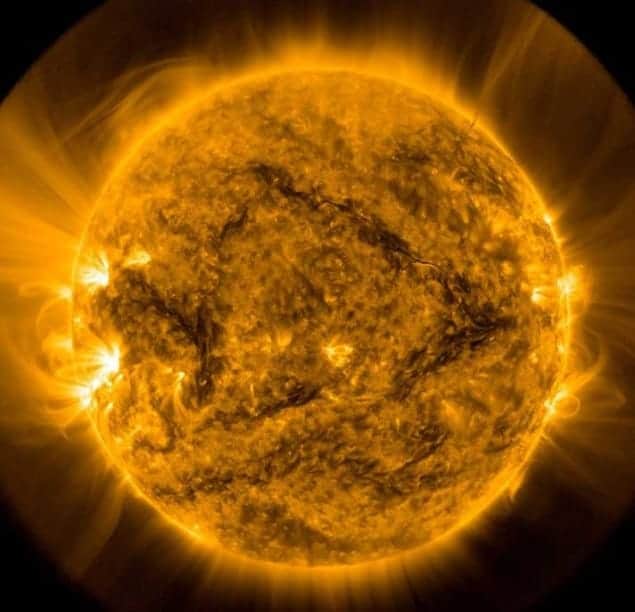
Sunlight is slowing the rotation of the Sun’s outermost layers by stealing its angular momentum. That is the claim of researchers in the US and Brazil who have studied acoustic waves oscillating through the Sun’s visible surface – the photosphere – to determine how fast the Sun spins at certain depths.
It has been known since the 1980s that the outer 5% of the photosphere rotates more slowly than deeper layers. However, solar physicists do not understand why this slowdown occurs, its total extent and its effect on the Sun’s magnetic dynamo and solar wind.
To solve this puzzle a team led by Ian Cunnyngham and Jeff Kuhn of the Institute for Astronomy at the University of Hawaii has observed acoustic waves at the limb (edge) of the Sun’s disc using the Helioseismic and Magnetic Imager on NASA’s Solar Dynamics Observatory (SDO), which orbits Earth.
Bell ringing
The Sun is ringing like a bell as acoustic waves driven by turbulence crash through the plasma within its interior. The waves themselves, known as p-mode oscillations, have very low frequencies in the region of 3000 µHz and their harmonic patterns form the basis of helioseismology.
Cunnyngham and Kuhn’s team observed the oscillations at the solar limb, where the viewing angle makes it possible to determine how deep in the photosphere each oscillation is, allowing measurements of the rotation velocity at each depth. They found that the greatest amount of braking was occurring in the outer 70 km of the photosphere and that layers closest to the surface were rotating more slowly than deeper layers. This differential rotation could potentially twist localized magnetic field lines, affecting magnetic phenomena such as sunspots, active regions and even the formation of the solar wind.
The upper 70 km of the photosphere is where the Sun starts to turn transparent and photons can finally escape into space as sunlight. It has been a long journey for those photons. Generated by nuclear fusion within the Sun’s core, the photons first enter the dense radiative zone that makes up the inner two-thirds of the Sun’s radius. The photons are repeatedly scattered by atomic nuclei and, after perhaps a million years, they reach the outer third of the Sun, known as the convection layer. Here the temperature is cool enough for atoms to absorb the photons. This couples the atoms and photons as they rise on convection currents. When they reach the outer 70 km, the atoms cool sufficiently to radiate the photons into space.
Shared angular momentum
Because the atoms and photons are coupled, they share angular momentum, but when the photons are released they take some of that angular momentum with them, leaving the atoms in the upper photosphere to rotate more slowly.
“Think about spinning a water hose over your head,” Jeff Kuhn tells physicsworld.com. “The water will leave the hose with tangential velocity and will therefore carry some angular momentum.”
The researchers liken it to the Poynting–Robertson effect, where the orbital motion of dust grains in space is slowed by the pressure they receive from solar photons that are moving tangentially to the grains.
This is a good explanation for a long-standing problem, and a nice example of what someone can do with excellent data and clever ideas
Dean Pesnell, NASA Goddard
According to Dean Pesnell SDO’s Project Scientist from NASA’s Goddard Space Flight Center, it is possible that there are other torques slowing the Sun that have yet to be identified, but until then, “this is a good explanation for a long-standing problem, and a nice example of what someone can do with excellent data and clever ideas”.
The Sun’s photosphere plays host to localized magnetic fields that, through the process of recombination, release energy into the solar corona that drives our physical connection with the Sun.
“We’re looking into how the fields would be twisted up and affect the solar wind,” says Kuhn.
Hotter stars
Deeper down, the rotation of the Sun affects how the solar dynamo generates its magnetic field. The braking effect could also have consequences for hotter stars that produce greater amounts of photons than the Sun. “A very luminous star could have a much larger drag in its outer layers, but it is unclear how this would affect the star’s evolution,” says Kuhn.
The research is described in Physical Review Letters
- There is much more about how the SDO is changing our understanding of the Sun in “Living with a star”



